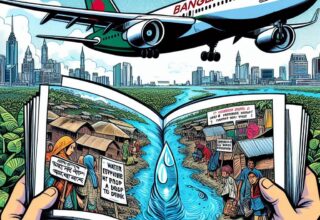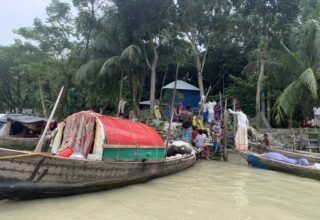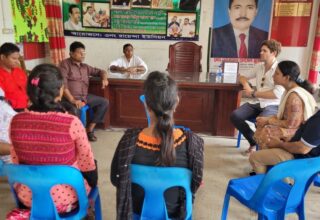“We are the people of coastal area, Our sufferings know no bounds, We have to survive fighting various disasters.” —Shagorika Mondol, song sung to pattachitra scroll on disaster awareness
How do you creatively inform the community about dealing with a tragedy that regularly befalls them? Or encourage them to stand back on their feet after a natural calamity strikes?
A troupe of performance artists from the small town of Shyamnagar, Satkhira, do this through a unique folk tradition of visual storytelling using a pattachitra (traditional scroll). The story depicts their tale of sufferings through colourful performances. The songs have catchy choruses, which once heard, are difficult to shake from one’s mind.
Our two-person team visited the town as a field visit as part of the TAPESTRY project in March 2021. We were happy to discover that the local cultural group ‘Jubo Shilpigoshthi’ in Shyamnagar had created scrolls that raised awareness of the impacts of climate change and natural disasters – very frequent visitors to this region. The artists were printing and singing about current events, as well as mythological subjects. Some of their scrolls commemorated the tragedies of natural disasters such as cyclones Aila and Amphan, while others promoted social issues, health education, and preventive measures against lack of sanitation or the coronavirus pandemic.
The long patas (scrolls) visually tell the story of preparing for disaster, in the form of paintings or printed pictures. An additional attraction is the rhythmic lyrics of an accompanying song. The choir composes a ‘pater gaan’ (narrative song) to go along with the printed scrolls. The team dances to the rhythm and beats of local instruments as they narrate the stories of the patas, following the style of narrating ballads. Shagorika, the lead singer of the team, told us that it took her about 15-20 days to write the lyrics, compose the song and print the scroll with relevant pictures.
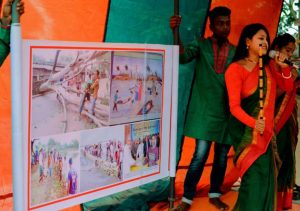
Her Pattachitra performance described the frequency of climate-influenced disasters in this southern coastal region, and their effects on local people. The performance highlighted how human activities like the deforestation of the Sundarbans have contributed to the rise in global temperatures, and influenced disasters such as floods, droughts, river erosion and tidal waves which occur every year, destroying their lives and livelihoods. Through the song, they answered questions on how to react, what to do and how to remain protected against damage if they are faced with a devastating tropical cyclone.
During the show, the Patuas (painters) gradually unfurled the long scrolls as the song continued:
“Be aware of the danger signals 9 and 10 You should stay safely together inside the shelters.”
Local people are trained on preparing for cyclones, and this training includes information on what the warning signals mean. But many people find this complicated, or they forget the meanings of the signals as time passes. When the same message comes through a melody of a song, accompanied by scrolls with pictures, the signals becomes easier for them to remember. Such activities have helped convince children and adults of the importance of evacuating to shelters – this is what a million people had to do as cyclone Aila and Amphan made their final approach.
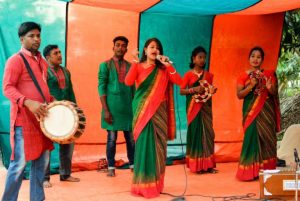
The lyrics also portrayed the sufferings of the coastal people, particularly the people of the Sundarbans, who rely on the mangrove forests, and make their living from agriculture, collecting honey or fishing activities. The song narrated how the traditional livelihood sources of the people have recently been at risk from frequent disasters. This aligns with the purpose of the TAPESTRY project, which is to understand the transformations in livelihood opportunities of coastal people, and how they can adapt to new changing environments or become more resilient to disasters.
Art historians have suggested that the traditional artform of pattachitra has been practised for over a thousand years in rural Bangladesh and some parts of India. Historically, pats were cloth scrolls on which mythological or historical and religious epic events and stories were painted as a sequence of frames. Pattachitras have been compared to cinema frames or animation, and are said to be one of the oldest forms of audio-visual communication.
More recently, pattachitra artists have broadened the tradition to include contemporary local and global events. They have begun telling stories from diverse social issues, like dowry and family planning, and issues related to health, as well as using the scrolls as an educational tool for advocating birth control, and awareness of the spread of HIV. In recent times, narrative pictures are printed in sheets instead of paintings.
Shagorika and her team usually perform during winter on the premises and courtyard of the house of a rich person or a leader of a village. Tents are set up, and an audience gathers and sits on mats on the ground as the performance goes on. Normally, the team would travel from one village to another to present their stories, but the pandemic has grounded them to their local area.
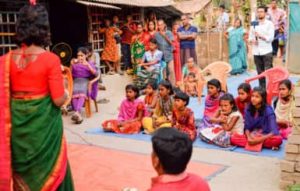
Meanwhile, the government and various NGOs have been working to raise awareness among the local people of these areas, through awareness training, Utthan-boithok (backyard meetings), posters, seminars, plays, songs and so on. Traditional mediums like pattachitra performances, with bright visuals and strong lyrical messages, serve the dual purpose of capturing people’s attention through entertainment and educating them on crucial issues.
Going forward, reviving thematic pattachitra performances could be an effective way to inform coastal people about transformative livelihood options and alternate livelihoods, while preserving the culture and traditions of the Sundarbans for years to come. It could also help to preserve a traditional art form with a thousand-year-old history, which is otherwise in danger of dying out.
About The authors- Sumaiya Binte Anwar and Mahmuda Akter both are Research Officer at ICCCAD.
Faizah Jaheen Ahmed is a Research Intern at ICCCAD.
Originally this blog was published on 16 August 2021 on STEPS Centre Website.

